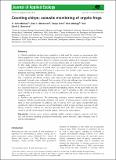Files in this item
Counting chirps : acoustic monitoring of cryptic frogs
Item metadata
| dc.contributor.author | Measey, G. John | |
| dc.contributor.author | Stevenson, Ben C. | |
| dc.contributor.author | Scott, Tanya | |
| dc.contributor.author | Altwegg, Res | |
| dc.contributor.author | Borchers, David L. | |
| dc.date.accessioned | 2016-12-02T00:33:35Z | |
| dc.date.available | 2016-12-02T00:33:35Z | |
| dc.date.issued | 2017-06 | |
| dc.identifier | 245997147 | |
| dc.identifier | 9e819670-c48a-42df-89bb-32c303b71ce9 | |
| dc.identifier | 85006152411 | |
| dc.identifier | 000401239100023 | |
| dc.identifier.citation | Measey , G J , Stevenson , B C , Scott , T , Altwegg , R & Borchers , D L 2017 , ' Counting chirps : acoustic monitoring of cryptic frogs ' , Journal of Applied Ecology , vol. 54 , no. 3 , pp. 894-902 . https://doi.org/10.1111/1365-2664.12810 | en |
| dc.identifier.issn | 0021-8901 | |
| dc.identifier.other | ORCID: /0000-0002-3944-0754/work/72842434 | |
| dc.identifier.uri | https://hdl.handle.net/10023/9921 | |
| dc.description | Funding for the frog survey was received from the National Geographic Society/Waitt Grants Program (No. W184-11). The EPSRC and NERC helped to fund this research through a PhD grant (No. EP/1000917/1) to D.L.B. R.A. and G.J.M. acknowledge initiative funding from the National Research Foundation of South Africa. | en |
| dc.description.abstract | 1 . Global amphibian declines have resulted in a vital need for monitoring programmes that follow population trends. Monitoring using advertisement calls is ideal as choruses are undisturbed during data collection. However, methods currently employed by managers frequently rely on trained observers, and/or do not provide density data on which to base trends. 2 . This study explores the utility of monitoring using acoustic spatially explicit capture-recapture (aSECR) with time of arrival (ToA) and signal strength (SS) as a quantitative monitoring technique to measure call density of a threatened but visually cryptic anuran, the Cape peninsula moss frog Arthroleptella lightfooti. 3 . The relationships between temporal and environmental variables (date, rainfall, temperature) and A. lightfooti call density at three study sites on the Cape peninsula, South Africa were examined. Acoustic data, collected from an array of six microphones over four months during the winter breeding season, provided a time series of call density estimates. 4 . Model selection indicated that call density was primarily associated with seasonality fitted as a quadratic function. Call density peaked mid-breeding season. At the main study site, the lowest recorded mean call density (0·160 calls m-2 min-1) occurred in May and reached its peak mid-July (1·259 calls m-2 min-1). The sites differed in call density, but also the effective sampling area. 5 . Synthesis and applications.The monitoring technique, acoustic spatially explicit capture–recapture (aSCR), quantitatively estimates call density without disturbing the calling animals or their environment, while time of arrival (ToA) and signal strength (SS) significantly add to the accuracy of call localisation, which in turn increases precision of call density estimates without the need for specialist field staff. This technique appears ideally suited to aid the monitoring of visually cryptic, acoustically active species. | |
| dc.format.extent | 9 | |
| dc.format.extent | 765102 | |
| dc.language.iso | eng | |
| dc.relation.ispartof | Journal of Applied Ecology | en |
| dc.subject | Acoustic spatially explicit capture-recapture | en |
| dc.subject | Signal strength | en |
| dc.subject | Time of arrival | en |
| dc.subject | Triangulation | en |
| dc.subject | Anurans | en |
| dc.subject | GE Environmental Sciences | en |
| dc.subject | QA Mathematics | en |
| dc.subject | QH301 Biology | en |
| dc.subject | DAS | en |
| dc.subject.lcc | GE | en |
| dc.subject.lcc | QA | en |
| dc.subject.lcc | QH301 | en |
| dc.title | Counting chirps : acoustic monitoring of cryptic frogs | en |
| dc.type | Journal article | en |
| dc.contributor.sponsor | EPSRC | en |
| dc.contributor.institution | University of St Andrews. Pure Mathematics | en |
| dc.contributor.institution | University of St Andrews. Centre for Research into Ecological & Environmental Modelling | en |
| dc.contributor.institution | University of St Andrews. School of Mathematics and Statistics | en |
| dc.contributor.institution | University of St Andrews. Marine Alliance for Science & Technology Scotland | en |
| dc.contributor.institution | University of St Andrews. Scottish Oceans Institute | en |
| dc.identifier.doi | 10.1111/1365-2664.12810 | |
| dc.description.status | Peer reviewed | en |
| dc.date.embargoedUntil | 2016-12-01 | |
| dc.identifier.grantnumber | EP/I000917/1 | en |
This item appears in the following Collection(s)
Items in the St Andrews Research Repository are protected by copyright, with all rights reserved, unless otherwise indicated.

